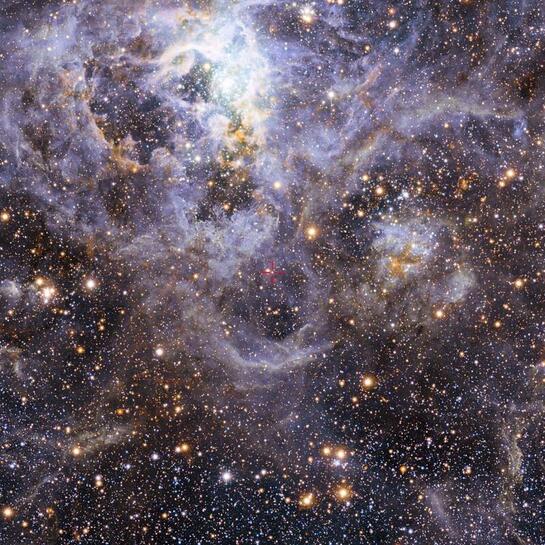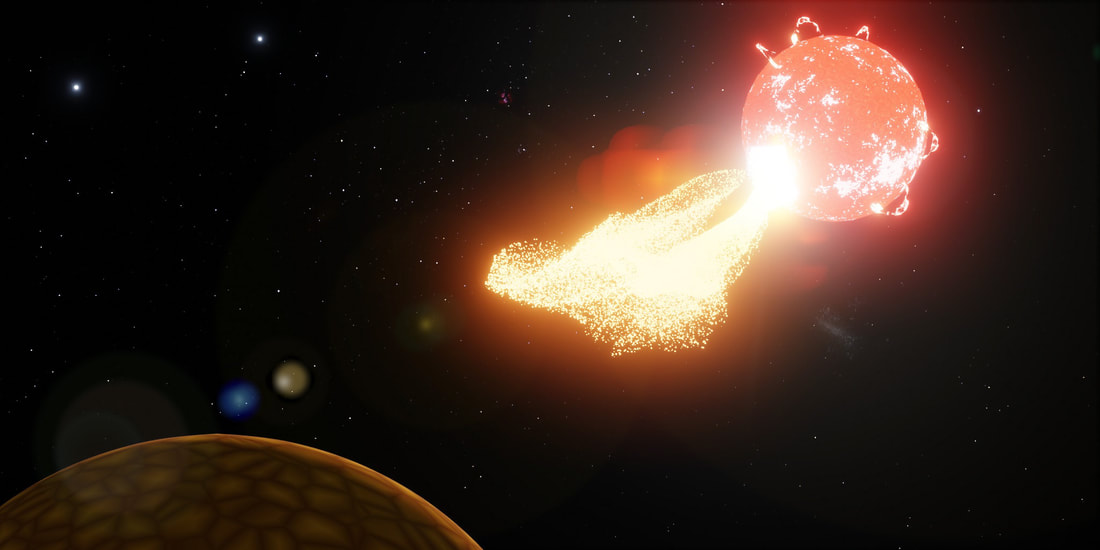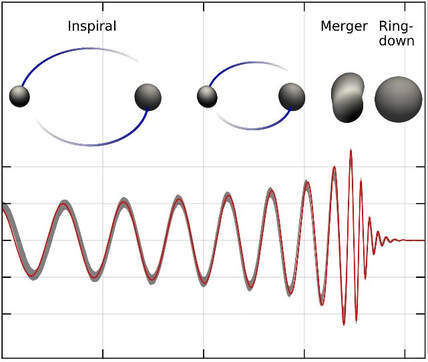|
A discovery that links stellar flares with radio-burst signatures will make it easier for astronomers to detect space weather around nearby stars outside the Solar System. Unfortunately, the first weather reports from our nearest neighbour, Proxima Centauri, are not promising for finding life as we know it. “Astronomers have recently found there are two ‘Earth-like’ rocky planets around Proxima Centauri, one within the ‘habitable zone’ where any water could be in liquid form,” said Andrew Zic from the University of Sydney. Proxima Centauri is just 4.2 light years from Earth. “But given Proxima Centauri is a cool, small red-dwarf star, it means this habitable zone is very close to the star; much closer in than Mercury is to our Sun,” he said. “What our research shows is that this makes the planets very vulnerable to dangerous ionising radiation that could effectively sterilise the planets.” Led by Mr Zic, under the supervision of OzGrav Associate Investigator Professor Tara Murphy, astronomers have for the first time shown a definitive link between optical flares and radio bursts on a star that is not the Sun. The finding, published in The Astrophysical Journal, is an important step to using radio signals from distant stars to effectively produce space weather reports. “Our own Sun regularly emits hot clouds of ionised particles during what we call ‘coronal mass ejections’. But given the Sun is much hotter than Proxima Centauri and other red-dwarf stars, our ‘habitable zone’ is far from the Sun’s surface, meaning the Earth is a relatively long way from these events,” Mr Zic said. “Further, the Earth has a very powerful planetary magnetic field that shields us from these intense blasts of solar plasma.” The research was done in collaboration with CSIRO, the University of Western Australia, University of Wisconsin-Milwaukee, University of Colorado and Curtin University, with contributions from the ARC Centre for Gravitational Wave Discovery (OzGrav) and University of California Berkeley. Zic said: “M-dwarf radio bursts might happen for different reasons than on the Sun, where they are usually associated with coronal mass ejections. But it’s highly likely that there are similar events associated with the stellar flares and radio bursts we have seen in this study.” Coronal mass ejections are hugely energetic expulsions of ionised plasma and radiation leaving the stellar atmosphere. “This is probably bad news on the space weather front. It seems likely that the galaxy’s most common stars – red dwarfs – won’t be great places to find life as we know it,” Mr Zic said. In the past decade, there has been a renaissance in the discovery of planets orbiting stars outside our Solar System. There are now more than 4000 known exoplanets. This has boosted hopes of finding ‘Earth-like’ conditions on exoplanets. Recent research says that about half the Sun-like stars in the Milky Way could be home to such planets. However, Sun-like stars only make up 7 percent of the galaxy’s stellar objects. By contrast, M-type red dwarfs like Proxima Centauri make up about 70 percent of stars in the Milky Way. The findings strongly suggest planets around these stars are likely to be showered with stellar flares and plasma ejections. Methodology The Proxima Centauri observations were taken with the CSIRO’s Australian Square Kilometre Array Pathfinder (ASKAP) telescope in Western Australia, the Zadko Telescope at the University of Western Australia and a suite of other instruments. OzGrav scientist Dr Bruce Gendre, from the University of Western Australia, said the research helps understand the dramatic effects of space weather on solar systems beyond our own. “Understanding space weather is critical for understanding how our own planet biosphere evolved – but also for what the future is,” Dr Gendre said. Professor Murphy said: “This is an exciting result from ASKAP. The incredible data quality allowed us to view the stellar flare from Proxima Centauri over its full evolution in amazing detail. “Most importantly, we can see polarised light, which is a signature of these events. It’s a bit like looking at the star with sunglasses on. Once ASKAP is operating in full survey mode we should be able to observe many more events on nearby stars.” This will give us much greater insights to the space weather around nearby stars. Other facilities, including NASA’s planet-hunting Transiting Exoplanet Survey Satellite and the Zadko Telescope observed simultaneously with ASKAP providing the crucial link between the radio bursts and powerful optical flares observed. Mr Zic said: “The probability that the observed solar flare and received radio signal from our neighbour were not connected is much less than one chance in 128,000.” The research shows that planets around Proxima Centauri may suffer strong atmospheric erosion, leaving them exposed to very intense X-rays and ultraviolet radiation. But could there be magnetic fields protecting these planets? Mr Zic said: “This remains an open question. How many exoplanets have magnetic fields like ours?” So far there have been no observations of magnetic fields around exoplanets and finding these could prove tricky. Mr Zic said one potential way to identify distant magnetic fields would be to look for aurorae, like those around Earth and also witnessed on Jupiter. “But even if there were magnetic fields, given the stellar proximity of habitable zone planets around M-dwarf stars, this might not be enough to protect them,” Mr Zic said. This is an extract of a media release originally written by the Media Office at the University of Sydney.
0 Comments
RESEARCH HIGHLIGHT: MASSIVE OVERCONTACT BINARY STARS OPEN A NEW WINDOW TO STELLAR EVOLUTION8/12/2020  The massive O4.5 V + O5.5 V binary VFTS 352 in the Tarantula Nebula (location indicated by the red cross) is one of the shortest-period and most massive overcontact binaries known. Recent theoretical studies indicate that some of these systems could ultimately lead to the formation of gravitational waves via black hole binary mergers through the chemically homogeneous evolution pathway. Image credit: ESO / M.-R. Cioni / VISTA Magellanic Cloud survey / Cambridge Astronomical Survey Unit. In 2015, the first direct observation of gravitational waves was made by the Advanced Laser Interferometer Gravitational-wave Observatory (aLIGO) (Abbott et al. 2016). The detected signal, known as GW150914, not only provided the most rigorous test of General Relativity—Einstein’s theory of gravity—it was also the first observation of two black holes merging. This confirmed the existence of black holes, binary stellar-mass black hole systems, and proved that they can merge within the current age of the Universe. Since that first detection, aLIGO has detected many more black hole mergers but scientists are still puzzled: many of the black hole mergers that aLIGO has detected so far, including GW150914, involve systems with the component black holes weighing-in at more than 20 solar masses each—some much more. These are massive black holes—heavier than any previously known black holes from X-ray binary observations—which raises the question: how did they form? Our recent study seeks to answer that question. aLIGO records (part of) the inspiral, merger, and ring-down of the orbiting black holes—as shown in figure 1[JR1] . aLIGO can only record these events if they occur within its operating lifetime—that means that the progenitor stars must collapse to black holes before they merge, and the subsequent orbiting black holes must spiral in towards each other and merge within the age of the Universe. For that to happen, the black holes must be big and close together; however, progenitor stars big enough and close enough to produce a binary black hole (BBH) system that would spiral in and eventually merge within the age of the universe, and that could generate gravitational waves detectable by aLIGO, would be too big and too close; so these progenitor stars merge first and then collapse into black holes. Thus, the aLIGO detections raise the intriguing questions: how did the black holes get so massive? and how did they get so close together? Chemically Homogeneous Evolution (CHE) has been proposed as a possible solution. Rapid spinning stirs a star leading to its interior becoming homogeneous, and possibly fusing entirely rather than just the core. A hot, rapidly spinning, chemically homogeneous star doesn’t expand as it ages in the way a conventionally evolving star does. The chemically homogeneous model begins with a pair of close, massive stars rotating around each other extremely rapidly—so close that they become tidally locked, causing the stars to spin rapidly on their own axes. The component stars of this massive, overcontact binary eventually collapse into massive black holes, which are now close enough to spiral in and merge within the age of the Universe. For the first time, we simultaneously explore conventional isolated binary star evolution and chemically homogeneous evolution under the same set of assumptions. This approach allows us to constrain population properties and make simultaneous predictions about the gravitational-wave detection rates of BBH mergers for the CHE and conventional formation channels. This joint model for the classical and CHE isolated binary evolution channels will enable simultaneous inference on binary evolution model parameters and the metallicity-specific star formation history once the full trove of observations from the aLIGO third gravitational-wave observing run is available. Ultimately, the relatively short delay times of CHE BBHs make them ideal probes of high-redshift star formation history; their high masses make them perfect targets for third-generation gravitational-wave detectors with good low-frequency sensitivity, such as the Einstein Telescope or the Cosmic Explorer. Written by OzGrav PhD student Jeff Riley - Monash University Link: https://arxiv.org/abs/2010.00002 |
|
- Home
- About
-
Our People
- Chief Investigators
- Partner Investigators
- Associate Investigators
- Postdocs and Students >
- Professional & Outreach staff
- Governance Advisory Committee
- Scientific Advisory Committee
- Executive Committee
- Equity & Diversity Committee
- Early Career Researcher Committee
- Professional Development Committee
- Research Translation Committee
- OzGrav Alumni
- Research Themes
- Education and Outreach
- Events
- News/Media
- Contact Us
- Home
- About
-
Our People
- Chief Investigators
- Partner Investigators
- Associate Investigators
- Postdocs and Students >
- Professional & Outreach staff
- Governance Advisory Committee
- Scientific Advisory Committee
- Executive Committee
- Equity & Diversity Committee
- Early Career Researcher Committee
- Professional Development Committee
- Research Translation Committee
- OzGrav Alumni
- Research Themes
- Education and Outreach
- Events
- News/Media
- Contact Us



 RSS Feed
RSS Feed








